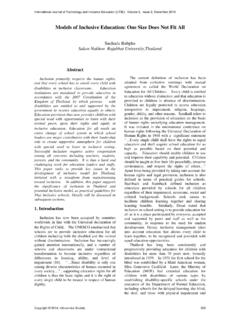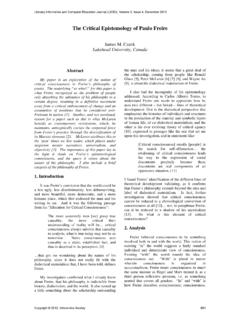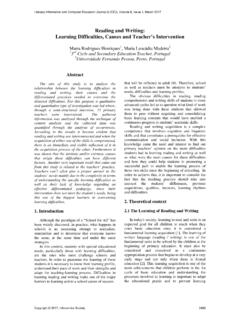Transcription of Students’ Adoption of Mobile Telephony in Higher Education ...
1 Students Adoption of Mobile Telephony in Higher Education institutions : Understanding the Influencing Factors Omotayo Kayode Abatan1, Nurudeen Ajayi2 1 School of Computing,University of South Africa 2 Discipline of IS & T, University of KwaZulu-Natal Abstract The universal telecommunications growth is largely attributed to rapid technological innovation and progressively more liberal policy environments. In the past, many developing countries implemented technical and legislative reforms that resulted in the increased Adoption of telecommunications technology.
2 This, in turn led to productivity improvements and the successful Adoption of Mobile Telephony . The Adoption of Mobile Telephony is influenced by many factors. This study identifies the factors that influence Information Technology (IT) students perceptions on the Adoption of Mobile Telephony and the quality of Mobile telecommunication services for academic and social purposes at the University of KwaZulu-Natal (UKZN), Durban, South Africa. The findings suggests that students understand and are fully aware of the use of Mobile telecommunication technology and its services as an important pedagogical tools in Higher Education institution.
3 The understanding of the significance of the various factors influencing the Adoption and usage of Mobile telecommunication services by students engenders opportunities to explore ways through which Mobile technology could be integrated into teaching and learning processes at Higher Education institutions . The integration of Mobile telecommunication technology into teaching and learning at universities has been identified in this study as a practice that can facilitate student-centered learning. 1. Introduction The introduction of the Global System for Mobile communications (GSM) technology by the European Union was criticized initially, but later turned out to be a productive decision.
4 Today, GSM technology has been adopted as a standard and boasts penetration rates never been reached before by any other technology [1]. Within a decade of the introduction of the standard, the number of Mobile telecommunication subscribers grew from less than one billion to almost four billion worldwide between 1996 and 2006 [2]. Today, the number of Mobile telecommunication subscribers has extended to an estimate of billion. The Universal Mobile Telecommunications System (UMTS) or 3G over GSM (2G Mobile technology) succeeded GSM and played a significant role in the Mobile telecommunication industry.
5 In the modeling of the 3G, Time Division Multiple Access (TDMA) was substituted with Code Division Multiple Access (CDMA), which supports the highest bandwidth of 2 Mbps, and it is said to be sufficient for future Mobile telecommunication loads [3]. However, the industry continues to evolve with 4G and now 5G being mooted as the latest incarnations of Mobile telecommunications. As a result, the Mobile telecommunication industry has experienced tremendous growth and rapid structural change. This study reviewed several academic literature on the factors that influence the Adoption of Mobile technology. The study further draws from students articulation of the quality of service they received, the significance of the factors and the relevance of Mobile telecommunication services for their academic and social activities.
6 In what follows, the paper discusses the models that anchors the study. Literature review on the factors influencing Mobile Telephony Adoption is presented, followed by the research design and findings. The final sections of this paper presents the discussion of findings and concludes the study with recommendations for the integration of Mobile technology into teaching and learning activities in Higher Education institutions . 2. Theoretical framework and trends Numerous studies have used the Technology Acceptance Model (TAM) and Theory of Planned Behaviour (TPB). In this study TAM was used as it suggests that attitude would be a direct predictor of the intention to use technology which would in turn impact upon the actual usage of the technology.
7 However, Davis and Venkatesh deemphasized the significance of attitude as a determinant of the use of technology but argue that perceived usefulness and perceived ease of use are critical factors that influence the use of technology [4]. The theory of planned behaviour is also used to understand people s intention to engage in a number International Journal Multimedia and Image Processing (IJMIP), Volume 6, Issues 1/2, March/June 2016 Copyright 2016, Infonomics Society312 of activities.
8 Some of the activities, which includes the use of Mobile telecommunication services for academic and social activities, were described in Siragusa and Dixon s [5] study. The perceptions of users around the world on the use of technology are reviewed in this section of the research. In Saudi Arabia, Al-Fahad [6] analysed students attitudes and perceptions towards the effectiveness of Mobile learning with the use of quantitative survey to focus on the importance of Mobile learning and teaching in university environment. It is understandable that students perception of Mobile learning may be influenced by certain distinct variables.
9 Such variables considered in this study were experiences, perceptions and attitudes to the technology. These variables are drawn parallel to that of Al-Fahad s survey mentioned above which considered gender, course of study and attitudes to new technology. Numerous studies carried out around the world have used technology acceptance model and theory of planned behaviour to support the strength and credibility of their research. TAM was considered to strengthen this study as it suggests that attitude would be a direct forecaster of the intension to use technology which would in turn predict the actual usage of the technology [4].
10 Bertrand and Bouchard applied TAM in the study on the acceptance of virtual reality (VR) with people who are favourable to its use. Standard items were adapted to test the TAM and added perceived cost factor which facilitated the role on intension to use the technology. TAM was adapted to identify, in an empirical method, the elements that play a role on the intension to use or not to use the technology in the study. To sum up, Chen et al. also applied the combination of TAM and innovation diffusion theory (IDT) to examine consumer behaviour in the virtual-store context. Their findings stipulated that the primary determinant of consumer attitudes towards using virtual-stores were compatibility, perceived usefulness and perceived ease of use.
















